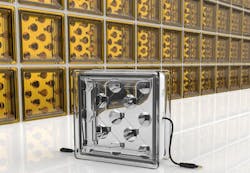Architectural glass blocks generate solar electricity while passing most light through
Two academics from the University of Exeter (Exeter, England) and a start-up expert have created a new take on photovoltaics: transparent architectural glass blocks that contain small arrays of concentrating mirrors and photovoltaic cells, but still pass most light through (see figure). Professor Tapas Mallick, Chair in Clean Technologies, and Dr. Hasan Baig, Research fellow, both based at the University of Exeter's Environment and Sustainability Institute in Cornwall, England, and IIB Research Commercialisation manager Jim Williams have created the technology.
The product, called Solar Squared, will not only be able to generate electricity while allowing daylight in, but will also provide improved thermal insulation, say the trio. According to the press release, "Solar Squared's patent-pending design consists of an array of optical elements that focus sunlight on small-sized solar cells. These are incorporated within the glass block during their manufacture and collect a large fraction of diffuse components of sunlight, even when placed on the vertical plane, making it particularly useful for capturing solar energy in urban areas."
The glass blocks can be used anywhere that standard architectural glass blocks can be used. Although the researchers don't describe the technical details, it appears (to this technical editor, at least) from the photo that small solid-glass Winston-type nonimaging concentrators (which can collect diffuse as well as directed light from the sun) are attached to the outer glass wall of the block, concentrating the light they accept onto small solar cells via total internal reflection. The concentrators cover perhaps 20% of the clear aperture of the block, allowing most light through to illuminate the building's interior.
"Buildings consume more than forty percent of the electricity produced across the globe," says Baig. "Deployment of standard solar technology is limited by the large area requirement and the negative visual impact. We wanted to overcome these limitations by introducing technologies that become a part of the building's envelope."
Solar Squared was developed by the Exeter team through a collaborative project with Cheshire-based Glass Block Technology Ltd. and a number of creative businesses in Cornwall. Managed by Jim Williams, product development included work with Falmouth University, Vital Spark Creative, and Engine House.
The team is looking for test sites to demonstrate the effectiveness and potential of Solar Squared and seeking investment for their start-up.
For more info, see https://www.buildsolar.co.uk
Source: http://www.exeter.ac.uk/business/expertise/aedm/engineering/solar
About the Author
John Wallace
Senior Technical Editor (1998-2022)
John Wallace was with Laser Focus World for nearly 25 years, retiring in late June 2022. He obtained a bachelor's degree in mechanical engineering and physics at Rutgers University and a master's in optical engineering at the University of Rochester. Before becoming an editor, John worked as an engineer at RCA, Exxon, Eastman Kodak, and GCA Corporation.

